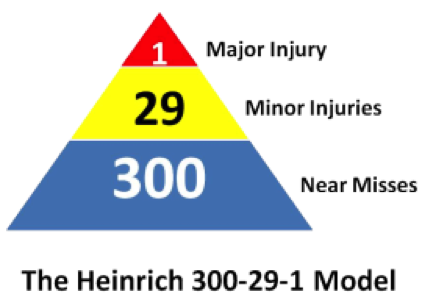 Every organization knows it must take action when an accident occurs at its plant or facility. Yet, for every fatal fall or incident, your enterprise experiences hundreds of accidents averted at the last minute.
Every organization knows it must take action when an accident occurs at its plant or facility. Yet, for every fatal fall or incident, your enterprise experiences hundreds of accidents averted at the last minute.
In the safety industry, these close calls are known as “near misses,” and while there’s no direct OSHA compliance regulations associated with near misses, that doesn’t mean your organization can afford to ignore them.
Instead of sweeping near misses under the rug, you must learn to leverage them for a stronger workplace safety culture at your facility.
Defining A Near Miss
While no official definition for a near miss is agreed upon across the safety industry, leaders generally agree that a near miss is an event where no injury, illness or damage occurred but if given a slight shift in time or position, an accident would have definitely happened. In contrast, an accident is defined as an unplanned event where injury or damage did occur.
Near misses most often occur due to a faulty process or a break down in a safety solution. Other industry terms for a near miss include “close call, “narrow escape,” “near collision” or “near hit.”
How Near Misses Are Related To Actual Accidents
Since near misses aren’t reported to OSHA, many safety leaders merely overlook them, stalling until an actual incident occurs instead. However, historical data has shown time and again that serious accidents are almost always preceded by warnings and near misses.
The employee safety pioneer and innovator H.W. Heinrich found that for every major injury or accident, there are 29 minor injuries and 300 near miss accidents. This data-driven ratio is most commonly known as Heinrich’s Triangle and has been a safety culture standard for years.
What A Near Miss Means For A Stronger Safety Culture
Instead of overlooking near miss incidents, you need to use them as a leading indicator to help you predict – and prevent – impending safety hazards. Use these data points to analyze what new safety practices should be implemented to prevent future injuries and accidents. Your return on investment for a risk analysis of a near miss is incredibly high since it helps prevent catastrophic accidents from occurring.
However, in order to leverage near miss data to strengthen your safety culture, you must have a reporting program in place so you’re aware of near misses at your work site. Every organization that implements a near miss reporting program has credited the programs with improving overall workplace safety as well as the culture of safety at their organization.
How To Collect Data On Near Misses
To prevent potentially fatal accidents, it’s essential that your near miss reporting program maximize the data you’re able to collect about close calls in your facility. One way to make sure you’re receiving data on all near misses is to remove any consequences for reporting a near miss incident. If employees feel insecure reporting a near miss, you won’t be able to proactively fix an impending issue, but if your safety culture encourages transparent reporting, you’re able to prevent fatal falls and accidents.
Another key facet of any near miss reporting program is to make it easy for employees to report close calls or known hazards. Workers should have several available outlets and channels to report a near miss, because if the process is too difficult or time-consuming employees won’t record the data.
Every near miss that occurs at your facility is a learning opportunity. If you leverage the data and reporting of near misses, you not only strengthen the safety culture and awareness of your company, but you’re also empowered to prevent future accidents from becoming fatal.
Need to keep your workplace moving efficiently while meeting corporate and OSHA compliance? Click below to download this industry guide from Carbis Solutions to discover the secrets to a safer – and more efficient – work site.



